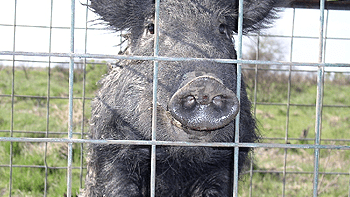NWDP: Feral Swine Disease Surveillance

NWDP collaborates with the National Feral Swine Damage Management Program on disease management, research, pathogen surveillance, emergency response, education and outreach regarding diseases of feral swine.
These non-native mammals can damage natural resources, agriculture, property, and human health and safety across the country and are considered invasive. They can be reservoirs of disease and may act as a host to a number of parasites, leaving the United States domestic swine industry vulnerable to disease.
Feral Swine Disease Monitoring
Surveillance for feral swine diseases is conducted by the National Feral Swine Damage Management Program. Efforts primarily focus on early detection of diseases that are not currently in the United States, including classical swine fever, African swine fever, and foot-and-mouth disease. Samples are also tested for pseudorabies virus and swine brucellosis. More than 6,000 feral swine samples per year are collected and screened for these pathogens through this surveillance program, providing important information that helps protect domestic animals, wildlife and humans from a major zoonotic disease outbreak.
African Swine Fever Monitoring Effort
African swine fever (ASF) is a highly contagious hemorrhagic viral disease of wild and domestic pigs, capable of killing entire herds and resulting in substantial economic and production losses globally. Outbreaks of this disease have occurred in sub-Saharan Africa, South America, and parts of Europe and Asia. Historically, ASF has been detected in several Caribbean Islands, including the Dominican Republic (DR), Haiti, and Cuba, but it has never been discovered in any U.S. state or territory. However, in response to recent ASF detections in the Caribbean, APHIS officials began an agency-wide effort to assist the DR and Haiti with their responses, as well as take action to prevent ASF from spreading to the mainland United States, Puerto Rico (PR) and the U.S. Virgin Islands (USVI).
Select Pathogens of Concern
- Classical swine fever
- African swine fever
- Foot-and-mouth disease
- Pseudorabies virus
- Swine brucellosis
- Influenza
- Bovine tuberculosis
- Porcine reproductive and respiratory syndrome
- Anthrax
- E. coli
More Information
- National Feral Swine Damage Management Program
- Disease Risks Associated With Increasing Feral Swine Population (995.43 KB)
- Feral Swine Numbers and Distribution in the United States
- Feral Swine Publications (search "feral swine")
- Feral Swine: Managing an Invasive Species
Contact Us
National Wildlife Disease Program
The National Wildlife Disease Program works with partners nationwide to conduct disease monitoring and surveillance in wild animals and is the primary emergency response contact point within APHIS Wildlife Services. Our program coordinator is available for questions about wildlife disease monitoring and surveillance, the status of disease outbreaks and emerging disease events, and wildlife emergency response activities in natural disasters (floods, hurricanes, wildfires) or oil spills.
Julianna Lenoch
National Wildlife Disease Program Coordinator
Email: julianna.b.lenoch@usda.gov
Phone: 970-266-6350

